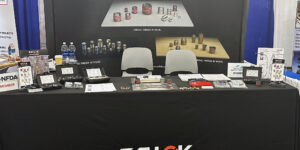CHOOSING AN ELECTROHYDRAULIC CONTROLLER
Machine builders once had misconceptions about hydraulic-based motion as not being exceptionally precise nor able to support highly complex, synchronized multi-axis applications. Not anymore. The team at Bosch Rexroth examines how the advent of closed-loop electrohydraulic motion controllers has changed the equation.
Posted: October 5, 2009
Machine builders and factory operators may have misconceptions about hydraulic-based motion. Although valued for its ability to move, crush or lift heavy loads, it has not been thought of as exceptionally precise, or able to support highly complex, synchronized multiaxis applications.
The advent of closed-loop electrohydraulic motion controllers has changed the equation, allowing production lines to be more precise and repeatable, as well as sophisticated and flexible. A range of electrohydraulic controller platforms are available.
Choosing the right one is based on assessing several factors, starting with the application requirements and including motion complexity, the number of axes to be controlled, and machine design and operational factors.
GROWTH OF CLOSED-LOOP HYDRAULIC CONTROL
Hydraulic motion control is the coordinated control of the acceleration, velocity and position, as well as force or pressure, of a machine axis or actuator such as a cylinder or hydraulic motor. Previous generation machines typically used open-loop control, sending a simple signal to a directional or proportional valve to control only one of these factors ? thus limiting the precision and sophistication of motion control. In addition, open-loop control often required manual fine-tuning, adding time and costs to machine commissioning or updating.
Closed-loop hydraulic control adds feedback to the hydraulic circuit by adding position and pressure sensors to the system, providing real-time data on system states like position, its derivatives and forces. This enables rapid, precise, repeatable, and (most importantly) automated position and force control of hydraulic actuators.
A number of simple applications can be configured using open-loop control, but quality requirements and high-throughput demands make closed-loop motion control and electrohydraulic controllers the preferred approach.
Going with a digital controller offers significant advantages. For the machine builder, the complexity and time of machine start up will be reduced. For series machines, once a digital control project template is created it can be applied to multiple machines with little extra effort or expense. For the end-user, process monitoring and machine diagnosis is built into the controller at no extra cost.
DECISION POINTS FOR CONTROLLER SELECTION
To choose the best controller for an application, start with four key decision points to assess and define during machine development. These key decision criteria include:
? Accuracy of the hydraulic axis stroke and positioning
? Need for single, combination or multi-axis control
? Preference for configuration or programming of motion sequences
? Bus architecture and I/O support.
ACCURACY OF STROKE AND FINE POSITIONING
Most closed-loop hydraulic controller product lines offer low-cost analog controllers to support basic motion requirements, such as simple position or flow control. However, since these controllers don?t incorporate digital feedback and processing, they generally do not provide accurate positioning at the endpoint. If you need stroke accuracy greater than 0.1 percent of the total stroke ? for example, no more than a tenth of an inch deviation over a 10 in stroke, you need the precise accuracy and stability provided by digital feedback and control.
Even if the motion is very simple and the path of travel does not require high accuracy, if fine positioning at the endpoint is required, such as micron-levels of accuracy for the machine tool or plastic industry, then analog controllers would be eliminated from the decision-making process.
DEFINE THE NUMBER OF AXES
Most digital electrohydraulic controller manufacturers offer a range of systems, with options based on application complexity. The next decision point is driven by how many axes you need the controller to support:
? Single axis
? Combination (2-4) axis
? Multi-axis (from 2 to 32)
Single-axis controllers are commonly used to replace analog controllers and are suited to a wide range of applications such as clamping, presses, materials handling, testing technology, steelworks and machine tools.
A common misconception is that single-axis controllers are ?simple? devices, supporting less than the full range of motion control. Most single-axis controllers support position, pressure, velocity and force control, as well as position or flow control, with bump-less transfer to pressure control, and active damping for improved dynamics.
Single-axis controllers can perform complex operations.
For example: a honing tool conducting a complex oscillating single-axis motion, working a cylinder cavity in an engine block. The axis of motion has an extremely precise endpoint and very precise control during the honing. If increasing friction or some other material factor is affecting the operation, the electrohydraulic controller adjusts velocity or force (or both) in real time to keep the actuator within microns of the target.
If an application has multiple axes with machine footprint space limitations, or requirements for more cost-effective control architecture, then you should consider using ?combination axis? controllers.
Combination axis controllers ? controlling up to four axes of motion ? provide a cost-effective option and provide the full range of position, pressure, velocity and force as well as ?master-slave? architecture. This avoids redundancies such as multiple bus interfaces, I/Os or space-consuming enclosures. It can also enhance the communication between axes for coordination, synchronization or safety purposes.
A master controller card handles bus communications and power distribution, with four other cards controlled by the master. This provides several efficiencies:
? Only a single power supply and bus communications link to the master card is needed
? Less equipment equals lower machine costs and better use of space
? Axis changes or updates can be uploaded to the master card instead of connecting and updating each controller.
Multi-axis controllers are the top-of-the-line systems, capable of handling up to 32 interpolatable axes. For example, one type of controller on the market controls the synchronization and interpolation of axes through an NC interpreter, which allows up to 32 NC programs to be processed in parallel. It is suitable for both standalone machines and operation within an integrated system.
ADVANTAGES OF CLOSED-LOOP CONTROLLERS
Providing accurate position and pressure feedback allows the controller to precisely control the overall motion. This has several advantages:
? More consistent motion, less wasted time and rejected parts.
? More flexible production, ability to easily modify a ?recipe? that changes the positions and forces during the machine cycle.
? Positions and forces can be changed while a machine is running, for greater flexibility.
? Pressure spikes that damage sensors and cause leaks can be reduced or eliminated.
? Machine downtime for production changeovers can be significantly reduced.
? Diagnostics and process monitoring can be facilitated using data obtained from the controller.
? Machine motion can adapt automatically to deal with different material consistencies and changes in environmental conditions.
? Closed-loop pressure control can ensure consistent production output quality from different machine operators.
This type of controller is typically used for applications such as presses, materials handling with cranes or truck lifts, steelworks and rolling mills, testing technology, and special machinery such as coal distributors, engine turning systems, etc.
THREE OPTIONS FOR CONTROLLER ?PROGRAMMING?
Once you determine whether you need a single-axis, combination-axis or multi-axis electrohydraulic controller, you need to evaluate the controller?s ?programming? tools according to the best fit for your application and operational requirements.
Most product lines offer three controller ?programming? options, with ascending levels of programming complexity. Choosing the most suitable will often be based on the sophistication, skills and experience of the programming and machine operator resources.
Single-axis controllers often use a menu-driven ?ladder-logic? configuration system that?s very easy to learn and use, and supports fast implementation of most standard single-axis motion sequences. For example, one controller on the market lets users select pre-stored sequences like PDT1 controllers, linear gain characteristics, and position-dependent braking. No programming is required.
For many manufacturers and operations, this more basic approach makes controller set-up a snap, and helps the transition from one machine design to another go smoothly. If you have an application that calls for bump-less transfer from velocity control to pressure control during a motion loop ? in a plastics injection molding machine, for example ? that kind of sequence is typically configurable, and can be easily and precisely implemented using pre-stored commands.
Motion sequence complexity at this level is limited to what the controller supplier provides in the configuration system. If more complex sequences are required, such as NC level functionality where the precision of either position or force through the motion loop requires real-time processing of algorithms in response to feedback, then you may need to choose a more powerful controller (either single or combination axis) that supports ?G-code? programming.
Unlike the configuration platform, this will require hands-on experience using a BASIC-type programming language. G-code commands are an industry standard machine language that lets users define motion sequences of the axes using freely programmable NC programs.
Besides standard commands, the best electrohydraulic controller platforms in this category support special NC commands tailored to the particular features of hydraulic axes, such as fields of closed-loop force/pressure control and limitation, transitions from closed-loop position to pressure control, and adaptive controller functions.
If your application calls for multi-axis synchronization and very complex control loops, the most effective and flexible controller is one that supports C-level programming. Applications requiring active synchronism with force limitation, or dynamically adding or withdrawing axes from a synchronized group during operation, call for advanced algorithms that need to be written in higher-level languages.
This programming approach also facilitates controller-level processing of complex motion sequences for more efficient machine control. In a CNC machine, for example, if a CAM profile is being machined, the controller accesses a look-up table with extremely fine variations in command values, guiding the actuator through a complex series of motions to complete the machining of the cam.
When an application such as this demands millisecond sampling and processing of feedback devices in the control loop, it is more efficient and more reliable to process motion control sequences at the controller level, rather than constantly communicating back and forth to a machine-level PLC. Therefore, choose a controller engineered to support both C-level programming of sequences, and powerful enough to handle one millisecond sampling and loop sequence processing.
BUS ARCHITECTURE AND I/O SUPPORT
As you identify the optimum controller platform, you must ensure the communications and power interfaces you need are fully supported. There are a number of bus architectures that electrohydraulic platforms support, including:
? DeviceNet
? ProfiBUS
? Interbus-S
? SERCOS Drive bus
? Ethernet
Most electrohydraulic controller product lines support several of these buses on each product, so the choice is often dependent on the communications backbone of the machine you?re building or upgrading. For analog and digital I/O, make sure the controller you select is equipped with enough I/O to support your application. For example, one Single-Axis Controller offers nine discrete inputs and eight outputs, while the MAC8 supports 32 inputs and 24 outputs.
FINDING THE RIGHT SUPPORT
Electrohydraulic controllers provide more options, and much more flexibility for implementing the precise, repeatable automation control architectures demanded by today?s global manufacturing infrastructure. It makes sense to look for a supplier that has in-depth experience engineering a wide range of motion control platforms across multiple technologies, combined with extensive experience in open and closed-loop hydraulics systems.
Suppliers that have overall system understanding and the capability to perform computer simulation of the static and dynamic behavior of the machine axes will be able to help you select the right electrohydraulic platform to meet all your performance requirements.
– – – – – – – – – – – – – – – – – – – – – – – – – – – – – –
Bosch Rexroth Hydraulics, 2315 City Line Road, Bethlehem, PA 18017-2131, 610-694-8300, www.boschrexroth-us.com.









